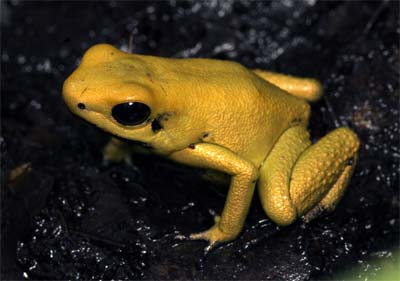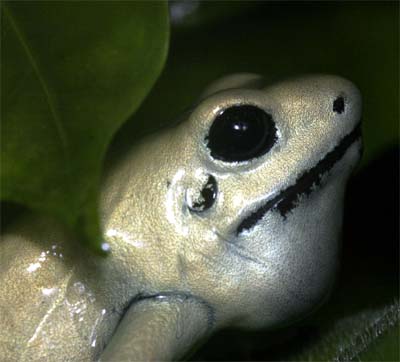|
Phyllobates terribilisis a great frog. In the wild they are some of the largest and are the most toxic of all the Poison Dart Frogs. This high toxicity allows them to be very bold. In captivity they lose the toxicity but none of the boldness. There are several color morphs available: mint, orange and yellow. Mint is the most readily available morph and because this morph is relatively common, they are inexpensive. We believe that the mint morph are the ideal beginner dart frog. Our mint P. terribilis rarely hide, so the frogs are easily observed even in a well-planted terrarium. We keep our P. terribillis in a heavily planted vivarium with a lot of leaf litter. They rarely use the upper 2/3 of the enclosure, but I have seen them sleep in the branches of our Ficus benjamina plants. We have both the mint and yellow morphs.
P. terribilis are difficult to sex, the females are only slightly larger than our males. People have reported that both females and males call. We have been keeping terribilis for over 5 years and have never heard one call. We have heard them vocalize, especially if another frog jumps on them but this sound is far different from a call. The male's call is a pleasant moderately loud thrill and lasts 10 seconds or so, the "call" of a female is a short harsh sound more of a chirp or a grunt. At least that is the only sound I have ever heard from a female.
P. terribilis are fairly prolific egg layers, once they get started. The eggs (10 - 20) are usually laid in a coco hut or similar bower. We leave the eggs in the enclosure for at least 24 hours after finding them to make sure that they are fertilized. The hatch rate for the eggs is sometimes low considering the large number deposited. This seems to be especially true for the orange morph frogs. We raise our tadpoles communally in a critter keeper or Rubbermaid container that is filtered with a small sponge type air filter. There are pathos and aquatic plants in the rearing enclosure. Tads are fed a mixture of spirulina, chlorella, stinging nettle and tetra tablets (2:2:1:1), we also feed "Aquarian" fish food about once a week. After the rear legs develop we expose the tads to UVB lighting daily. They morph out large and are fed Drosophila melanogaster that are dusted with Repcal. We also dust a couple times a week with Herptivite. We follow this dusting regime with our adult frogs too. We raise the froglets in small groups in 19qt Rubbermaid containers with soil, leaf litter and pathos in it. The froglets lose their juvenile color in 3 – 5 months, they take a long time to mature, becoming full adults in 15-18 months. |
P. terribilis are very easy to feed. They are very aggressive feeders and will really try to eat just about anything. They are not fussy eaters and accept a large variety of foods. This can be a critical factor when a beginning frogger runs out of fruit flies or has a culture crash. Many local and large scale pet shops carry small 3-4 week old crickets that can be consumed by adult and juvenile frogs to get you through until the cultures get going again. We regularly feed ours house flies, moths and large field sweepings, we have even seen them eat earthworms!
|
 |
 |
In our experience we have noted that P. terribilis are less tolerant of high temperatures than some of the other dart frogs. In the spring of 2000 we lost an entire breeding group because of a heat wave in early May. Most of our other frogs were unaffected. For this reason we recommend temperature probes in every enclosure (there can be as much as a 5% difference in enclosures that are right next to each other) and not letting the temperature rise above 83°.
Summation:
Size- 35 - 45 mm, females are slightly larger than males
Care- The mint and yellow morphs are easy to care for, The orange morph may be a bit more challenging
Food- all types of fruit flies, small- medium crickets, waxworms, confused flowerbeetle larvae, termites, house flies, beetles, field sweeping
Eggs and Tads- large clutches, tads are omnivorous and can be kept communally
Temperature- 70°-80°
|

